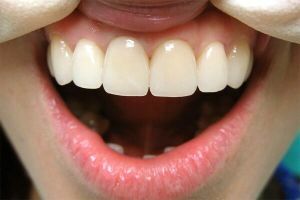 Probably there is not a single person who would not lose his teeth during his life if he lived at least 40 years. Without recalling the natural loss of milk teeth, the indigenous ones are also removed.
Probably there is not a single person who would not lose his teeth during his life if he lived at least 40 years. Without recalling the natural loss of milk teeth, the indigenous ones are also removed.
And sometimes we lose if not the whole tooth as a result of trauma, then a certain part of it. Smiling and diction become less attractive, and eating is painful. An address to the dentist will be the right step, but he will not be able to produce a permanent prosthesis for one visit.
For this, there is a temporary prosthetics service for teeth. It can be temporary removable bridges and crowns fixed on cement. The patient can calmly continue to communicate, not embarrassed by his appearance.
Contents
- Functional need for
- What does modern dentistry offer?
- Manufacturer and installation of
- Advantages and capabilities of
- Advantages and capabilities of
- Adaptation process
- Possible problems and their sources
- Features of care
- Contraindications to
- installation
- opinion Price of issue
- Advantages and capabilities of
Functional need for
In situations that people sometimes encounter, temporary prosthesiscan be of invaluable help. And this is not a tribute to fashion, but a necessity.
For example, a person decided to replace damaged teeth or fill the gaps formed when they were removed. Immediately put a permanent implant is not recommended. The reason is that after the installation of an implant with a heavy crown, the healing process becomes difficult. A temporary crown is easier and does not interfere with the regeneration of the gums.
Also, "prosthesis per hour" is necessary if the patient grinds the tooth for a future ceramic crown. The temporary product will hide 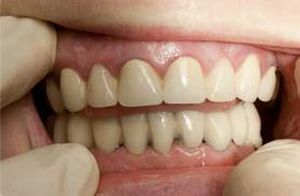 cosmetic ugliness of a smile, save from the effect of food processed by the dentist "stump".
cosmetic ugliness of a smile, save from the effect of food processed by the dentist "stump".
In this case, the temporary bridge can even be loaded with a chewing function, until the dental technician makes a permanent design, and a few days or weeks will go into the fit. Without such an opportunity, the entire period would have to walk with a defect, afraid to open mouth in society. And then the question is not only aesthetics, there is also an influence on speech, it is also necessary to protect the bone tissue of the treated area.
Lightweight plastic prosthesis will help temporarily solve this problem. Dentists say that wearing temporary crowns or bridges will facilitate the process of getting used to permanent, non-removable artificial products.
More systematically, all the benefits of using temporary bridges and crowns can be identified in this list:
- is chewed while a permanent substitute is being manufactured;
- provides an aesthetic appearance of the tooth row in the absence of a tooth or the presence of a twisted hemp;
- products keep the gum open from injury and infection;
- jaw bones are loaded fully and evenly, which will protect them from deformation and atrophy.
What does modern dentistry offer?
There are several types of dental structures for temporary installation. The main division occurs on the principle of prosthetics: removable or non-removable products.
Butterfly prostheses, also called immediates, are of the first type. The material for manufacturing is hypoallergenic 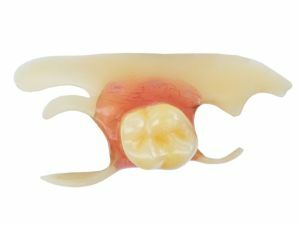 plastic. Typically, such a prosthesis consists of one or two removable teeth, and for the attachment in the form of nylon petals clings to adjacent teeth. They can not even be seen on the background of the gums, as they merge with the soft tissues of the jaw.
plastic. Typically, such a prosthesis consists of one or two removable teeth, and for the attachment in the form of nylon petals clings to adjacent teeth. They can not even be seen on the background of the gums, as they merge with the soft tissues of the jaw.
The color and shape of the plastic parts will be chosen by a good specialist without much difficulty, comparing the tonality of the artificial structures with the patient's natural teeth.
Prostheses of non-removable type are made on the basis of crowns and bridges, fixed on supporting teeth. The design is installed so firmly and reliably that the person himself can not remove it.
Wearing temporary products will well prepare the enamel of the teeth and gums for the installation of permanent structures. Metal or ceramic crowns will not give a quality implant to a dental implant, as a temporary bridge or crown will do.
Manufacture and installation of
Before installing temporary structures, the attending physician diagnoses the condition of the oral cavity and gums, examines the options for using these or those types of prosthetics.
If it is possible to install a removable denture, the dentist tries to take into account all the points: the strengths and weaknesses of such products, the consequences for the gums of a particular patient and even the cost.
The patient will have to transfer not only the sanation of the oral cavity, but also several more mandatory steps:
- discussion with the doctor of the pros and cons of using a particular variant of prosthetics;
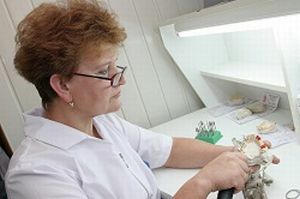
- treatment of adjacent teeth, on which the design will be installed;
- direct prosthetics involves taking a snapshot from each jaw and imprinting the location of the dental units;
- imitation on the model of a damaged and removed tooth;
- definition of the changes that will occur on the mucosa after the removal of one of the incisors is completed;
- dental technician prepares wax model of bridge or crown in his laboratory;
- prosthesis in the patient's jaw sits on a gel or glue;
- indirect manufacture involves the initial removal of the affected tooth, and only then the impression is taken and a temporary crown is prepared.
Most notable and most needed
As front teeth are more open to surrounding people, their damage or total absence is very noticeable. A person is ashamed of the problem and tries to solve it in a short time. But while a permanent prosthesis will be manufactured, some time will pass. And the doctor can suggest using temporary plastic products.
It is enough just once to visit a specialist to install an emergency design for a short period of time. These can be plates on the front teeth, if it is a question of their prosthetics or the removal of a particular cutter. Sometimes they offer a crown if one cutter is damaged.
Often temporary prosthetics of the anterior incisors do not require turning of supporting teeth. They fix them by the method of direct gluing with the use of elastic materials. Apply the beam method, pre-installed in adjacent teeth an additional design, which will be attached to the entire product.
In the photo, temporary crowns installed on the front teeth:
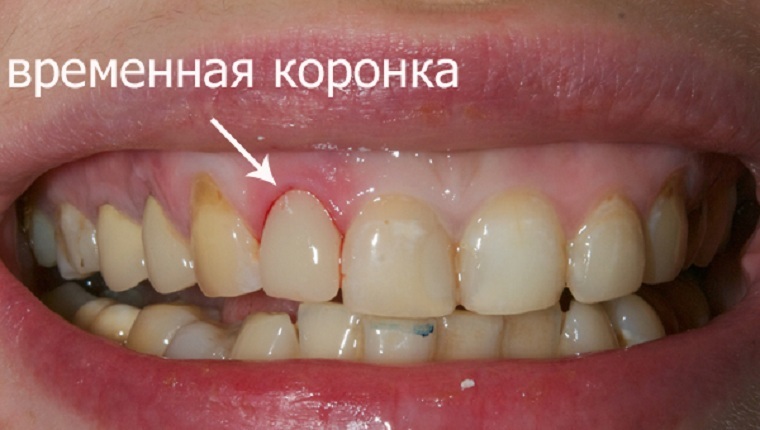
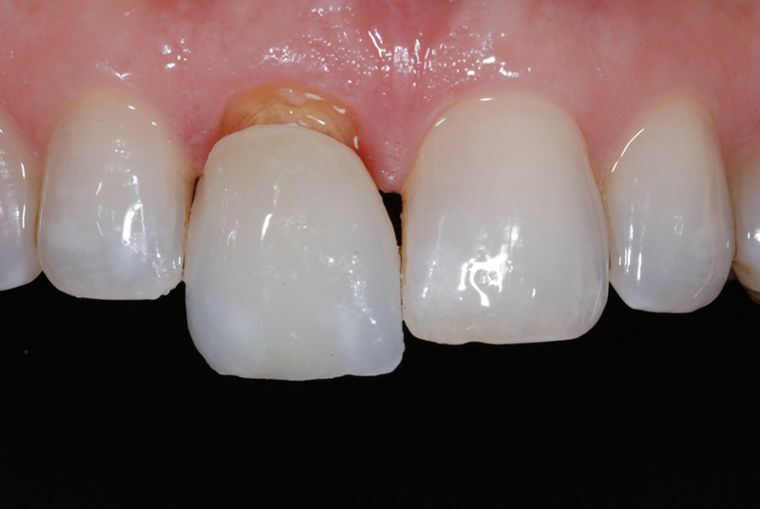
Advantages and features of
These constructions have become very popular among people who are forced to undergo a multi-day preparation for the installation of permanent artificial teeth or bridges.
While the final product is in processing and waiting for its hour, the patient is already leading a full life, chewing without interference, communicating with people without shame.
If a person is to install veneers, temporary prostheses will help evaluate the final permanent structure.
In the treatment of gum disease, temporary prostheses are also installed. The doctor at the same time observes the moment when the gum condition improves and more reliable permanent structures can be installed.
Adaptation process
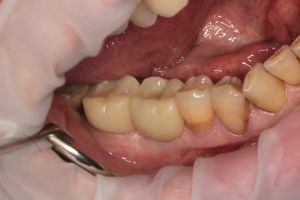 It would seem a question: why get used to temporary teeth, they will still be removed? Is not it better to adjust yourself to adapt to a permanent product? But getting used to wearing short-term products, a person will be easier to restructure and to permanent prostheses.
It would seem a question: why get used to temporary teeth, they will still be removed? Is not it better to adjust yourself to adapt to a permanent product? But getting used to wearing short-term products, a person will be easier to restructure and to permanent prostheses.
Not all people are comfortable regarding the long finding in their oral cavity of some additional object. They need to get used to such an extent that they just do not notice the foreign body in their mouths.
Dentists have developed a special massage, in which the person himself massages that part of the gum in the place where the product will stand.
Possible problems and their sources
Alas, but there are sad statistics, through which you can identify the most common complications that occur even with prosthetics for a short time.
The most common problems can be:
- rubbed from the prosthesis;
- galvanism;
- stomatitis and inflammation of gums covered with dentures;
- cheeks and lips change their position;
- fixing of structures weakens.
The main prerequisites that provoke such consequences are:
- the unprofessionalism of a dentist or dental technician;
- failure by the patient to follow the recommendations of the attending physician;
- is the reaction of the body, which can not be predicted in advance.
When the artificial crown is very tight against the gum, prosthetic stomatitis occurs. The pressure of the construction on the gum breaks the blood circulation in it, the tissues in this place die off. To avoid the development of the disease, a specialist prescribes washing the mouth with antiseptics and hydrogen peroxide.
When the gap is left for the gum to "breathe" and not to be subjected to excessive pressure, food sticks there, which leads to the appearance of caries. But if you worry about regular oral hygiene, then the caries chances to develop will be significantly less.
Allergy to the materials from which prostheses are made. It is difficult to predict this cause of complications in advance, but its nature is partly understandable. The reaction occurs when the prosthesis and the oral tissues of the oral cavity are in contact. Usually, the following symptoms are detected: burning and plaque in the tongue, skin rash, asthmatic attack.
Features of care
As natural teeth need to be cleaned, so are artificial ones. If food constantly gets into the gap between the prosthesis and living  tissues, then it becomes a source of bad breath, with time the gums will begin to ache and swell. Especially carefully it is necessary to carry out hygienic measures in the places of fixing the prosthesis to living tissue. Dentists recommend using a medium-hard brush for this purpose.
tissues, then it becomes a source of bad breath, with time the gums will begin to ache and swell. Especially carefully it is necessary to carry out hygienic measures in the places of fixing the prosthesis to living tissue. Dentists recommend using a medium-hard brush for this purpose.
Rinse mouth is not only water, but also pre-cooked broths of chamomile, calendula and sage. The pharmacy also has rinsers for those who do not want to cook them themselves.
With permanent constructions it is somewhat more complicated. For the period of using temporary prostheses, it is necessary to refrain from hard and sticky food. It is necessary not to allow a lot of pressure on the plate with the chewing load.
The dental floss can be used for cleaning, but you must not allow any sudden movements, you need to slowly pull it away from the face.
Contraindications to installation of
In rare cases, temporary teeth should not be installed at all. There are not many reasons for these, but they are.
If, for some time before the prosthesis, the patient has had infections in the oral cavity, then it should be awhile to await the complete recovery of all tissues.
When the doctor is not sure that the implant will get used, you will also have to wait a while. As soon as the reasons for doubt disappear, the question of prosthetics can be returned again.
Installing an immediate can do little to interfere. However, if inflammation of soft tissues is detected, it is necessary to abstain for a time even from such an option.
There is an opinion of
Review of the patient, who was installed a temporary nylon dental plate.
When at the age of 20 I was removed the front tooth, I put a metal crown. But by the age of 30, the root had cracked, and there was nothing to hold on to the crown. The dentist suggested a nylon denture as a temporary measure. I got used to it for a relatively short time, it felt as if there was something superfluous in my mouth and I wanted to spit it out.
It's been 4 years, and I have not parted with him. Not everything suits it already, it has shaken, and it is necessary to clean it, removing it. I feel like a grandmother.
The advantages will be that there is no need to grind adjacent teeth to install the bridge.
But this is better than smiling "face in a hole" and suffer even more discomfort from the views of others.
Alina, 34
Price
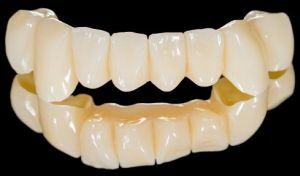 With the rise in price of all services and materials, prices are constantly changing. Not so long ago, the "butterfly" for one tooth cost 600-1000 rubles. Now in the region of 2000.
With the rise in price of all services and materials, prices are constantly changing. Not so long ago, the "butterfly" for one tooth cost 600-1000 rubles. Now in the region of 2000.
Everything depends not only on the cost of services in each clinic, but also on the initial price of the material itself, chosen for the construction.
A temporary dental product can become a subject of long wearing just because not everyone can afford a more expensive implant. Knowing this, many parents should teach their children to care for the health of the oral cavity.
But if the damage for some reason takes place, temporary prosthetics will retain the aesthetic appearance and ability to chew food while there are funds for something more permanent.
